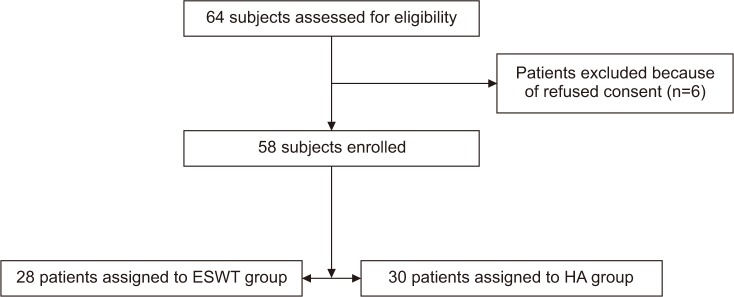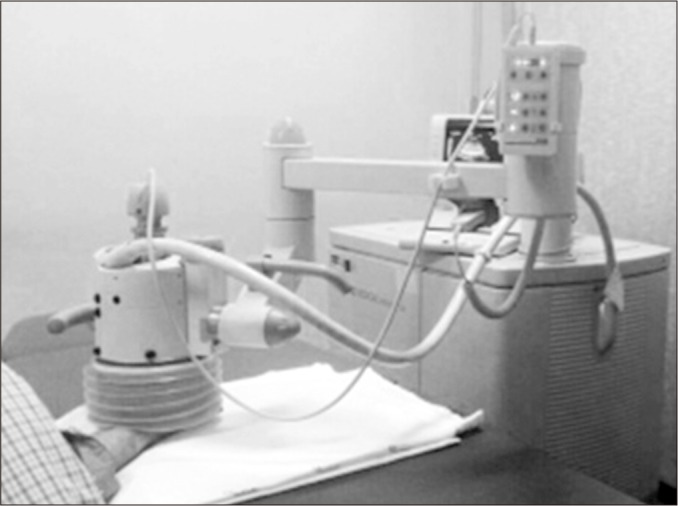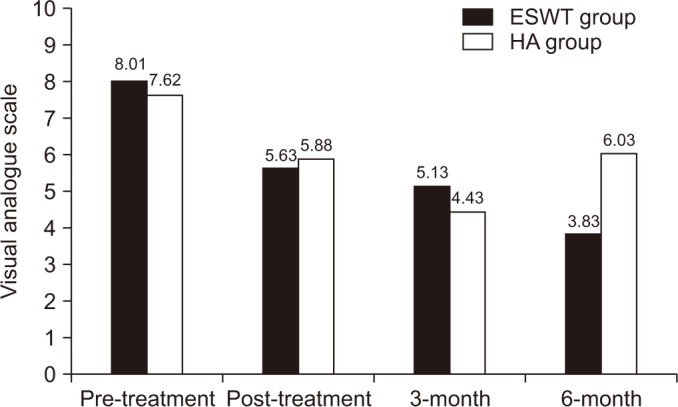Ann Rehabil Med.
2018 Feb;42(1):92-100. 10.5535/arm.2018.42.1.92.
Comparison Between Extracorporeal Shock Wave Therapy and Intra-articular Hyaluronic Acid Injections in the Treatment of First Carpometacarpal Joint Osteoarthritis
- Affiliations
-
- 1Department of Physical Medicine and Rehabilitation, Sapienza University of Rome, Rome, Italy. teresa.venditto@hotmail.it.
- 2Emergency Department of Plastic Surgery and Hand Surgery, Sapienza University of Rome, Rome, Italy.
- 3Department of Life, Health and Environmental Sciences, School of Medicine, University of L'Aquila, L'Aquila, Italy.
- KMID: 2440974
- DOI: http://doi.org/10.5535/arm.2018.42.1.92
Abstract
OBJECTIVE
To compare extracorporeal shockwave therapy (ESWT) with hyaluronic acid (HA) intra-articular injections in terms of pain relief, improvement in hand function, and strength in subjects with first carpometacarpal (CMC) joint osteoarthritis.
METHODS
Fifty-eight patients received either focused ESWT or HA injection once a week for 3 consecutive weeks. In the ESWT group, 2,400 consecutive pulses were performed during each treatment session using a frequency of 4 Hz and an energy flux density of 0.09 mJ/mm2. The HA group underwent one cycle of three injections of 0.5 cm3 HA. The main outcome measures were pain and hand function as measured by the visual analogue scale (VAS) and Duruoz Hand Index (DHI), respectively. The secondary outcomes were grip and pinch strength. Each assessment was performed at baseline, at the end of treatment, and at 3- and 6-month follow-up visits.
RESULTS
According to VAS and DHI scores, a significant change in test performance was observed over time in both groups (p < 0.001), with a greater average improvement in painful symptomatology at the 6-month follow-up in the ESWT group. A significant improvement in strength was observed in both groups, but the ESWT group showed better results on the pinch test starting immediately at the end of treatment.
CONCLUSION
The use of ESWT in patients with first CMC joint osteoarthritis leads to a reduction in pain, an improvement in pinch test performance that persists for at least 6 months, and a decrease in hand disability up to the 6-month follow-up visit.
MeSH Terms
Figure
Reference
-
1. Arden NK, Leyland KM. Osteoarthritis year 2013 in review: clinical. Osteoarthritis Cartilage. 2013; 21:1409–1413. PMID: 23831667.
Article2. Wajon A, Vinycomb T, Carr E, Edmunds I, Ada L. Surgery for thumb (trapeziometacarpal joint) osteoarthritis. Cochrane Database Syst Rev. 2015; 23:CD004631.
Article3. Heyworth BE, Lee JH, Kim PD, Lipton CB, Strauch RJ, Rosenwasser MP. Hylan versus corticosteroid versus placebo for treatment of basal joint arthritis: a prospective, randomized, double-blinded clinical trial. J Hand Surg Am. 2008; 33:40–48. PMID: 18261664.
Article4. Cook GS, Lalonde DH. MOC-PSSM CME article: management of thumb carpometacarpal joint arthritis. Plast Reconstr Surg. 2008; 121(1 Suppl):1–9.
Article5. Davis AM, MacKay C. Osteoarthritis year in review: outcome of rehabilitation. Osteoarthritis Cartilage. 2013; 21:1414–1424. PMID: 23942064.
Article6. Mader R, Lavi I, Luboshitzky R. Evaluation of the pituitary-adrenal axis function following single intraarticular injection of methylprednisolone. Arthritis Rheum. 2005; 52:924–928. PMID: 15751089.
Article7. Gigante A, Callegari L. The role of intra-articular hyaluronan (Sinovial) in the treatment of osteoarthritis. Rheumatol Int. 2011; 31:427–444. PMID: 21113807.
Article8. Spaans AJ, van Minnen LP, Kon M, Schuurman AH, Schreuders AR, Vermeulen GM. Conservative treatment of thumb base osteoarthritis: a systematic review. J Hand Surg Am. 2015; 40:16–21. PMID: 25534834.
Article9. Monfort J, Rotes-Sala D, Segales N, Montanes FJ, Orellana C, Llorente-Onaindia J, et al. Comparative efficacy of intra-articular hyaluronic acid and corticoid injections in osteoarthritis of the first carpometacarpal joint: results of a 6-month single-masked randomized study. Joint Bone Spine. 2015; 82:116–121. PMID: 25311256.
Article10. Ioppolo F, Tattoli M, Di Sante L, Attanasi C, Venditto T, Servidio M, et al. Extracorporeal shock-wave therapy for supraspinatus calcifying tendinitis: a randomized clinical trial comparing two different energy levels. Phys Ther. 2012; 92:1376–1385. PMID: 22745199.
Article11. Peled E, Portal-Banker T, Norman D, Melamed E. Plantar fasciitis and extracorporeal shock wave therapy: essence, diagnosis and treatment methods. Harefuah. 2011; 150:122–126. PMID: 22164939.12. Sems A, Dimeff R, Iannotti JP. Extracorporeal shock wave therapy in the treatment of chronic tendinopathies. J Am Acad Orthop Surg. 2006; 14:195–204. PMID: 16585361.
Article13. Ioppolo F, Rompe JD, Furia JP, Cacchio A. Clinical application of shock wave therapy (SWT) in musculoskeletal disorders. Eur J Phys Rehabil Med. 2014; 50:217–230. PMID: 24667365.14. Wang CJ, Huang HY, Pai CH. Shock wave-enhanced neovascularization at the tendon-bone junction: an experiment in dogs. J Foot Ankle Surg. 2002; 41:16–22. PMID: 11858601.
Article15. Mariotto S, de Prati AC, Cavalieri E, Amelio E, Marlinghaus E, Suzuki H. Extracorporeal shock wave therapy in inflammatory diseases: molecular mechanism that triggers anti-inflammatory action. Curr Med Chem. 2009; 16:2366–2372. PMID: 19601786.
Article16. Dahlberg J, Fitch G, Evans RB, McClure SR, Conzemius M. The evaluation of extracorporeal shockwave therapy in naturally occurring osteoarthritis of the stifle joint in dogs. Vet Comp Orthop Traumatol. 2005; 18:147–152. PMID: 16594445.
Article17. Revenaugh MS. Extracorporeal shock wave therapy for treatment of osteoarthritis in the horse: clinical applications. Vet Clin North Am Equine Pract. 2005; 21:609–625. PMID: 16297724.
Article18. Moretti B, Iannone F, Notarnicola A, Lapadula G, Moretti L, Patella V, et al. Extracorporeal shock waves down-regulate the expression of interleukin-10 and tumor necrosis factor-alpha in osteoarthritic chondrocytes. BMC Musculoskelet Disord. 2008; 9:16. PMID: 18237379.
Article19. Kim JH, Kim JY, Choi CM, Lee JK, Kee HS, Jung KI, et al. The dose-related effects of extracorporeal shock wave therapy for knee osteoarthritis. Ann Rehabil Med. 2015; 39:616–623. PMID: 26361599.
Article20. Altman R, Alarcon G, Appelrouth D, Bloch D, Borenstein D, Brandt K, et al. The American College of Rheumatology criteria for the classification and reporting of osteoarthritis of the hand. Arthritis Rheum. 1990; 33:1601–1610. PMID: 2242058.
Article21. Eaton RG, Littler JW. Ligament reconstruction for the painful thumb carpometacarpal joint. J Bone Joint Surg Am. 1973; 55:1655–1666. PMID: 4804988.
Article22. Hirschfeld M, Galan A, Arenas J, Del Aguila B, Benitez-Parejo N, Costa JA, et al. Inter-observer agreement on the Eaton-Littler classification of trapeziometacarpal joint osteoarthritis. Rev Esp Cir Ortop Traumatol. 2014; 58:237–241. PMID: 24821479.
Article23. Hawker GA, Mian S, Kendzerska T, French M. Measures of adult pain: visual analog scale for pain (VAS Pain), numeric rating scale for pain (NRS Pain), mcgill pain questionnaire (MPQ), short-form mcgill pain questionnaire (SF-MPQ), chronic pain grade scale (CPGS), short form-36 bodily pain scale (SF-36 BPS), and measure of intermittent and constant osteoarthritis pain (ICOAP). Arthritis Care Res (Hoboken). 2011; 63(Suppl 11):S240–S252. PMID: 22588748.24. Duruoz MT, Poiraudeau S, Fermanian J, Menkes CJ, Amor B, Dougados M, et al. Development and validation of a rheumatoid hand functional disability scale that assesses functional handicap. J Rheumatol. 1996; 23:1167–1172. PMID: 8823687.25. Brower LM, Poole JL. Reliability and validity of the Duruoz Hand Index in persons with systemic sclerosis (scleroderma). Arthritis Rheum. 2004; 51:805–809. PMID: 15478150.26. Fuchs S, Monikes R, Wohlmeiner A, Heyse T. Intra-articular hyaluronic acid compared with corticoid injections for the treatment of rhizarthrosis. Osteoarthritis Cartilage. 2006; 14:82–88. PMID: 16242353.
Article27. Stahl S, Karsh-Zafrir I, Ratzon N, Rosenberg N. Comparison of intraarticular injection of depot corticosteroid and hyaluronic acid for treatment of degenerative trapeziometacarpal joints. J Clin Rheumatol. 2005; 11:299–302. PMID: 16371798.
Article28. Notarnicola A, Moretti B. The biological effects of extracorporeal shock wave therapy (ESWT) on tendon tissue. Muscles Ligaments Tendons J. 2012; 2:33–37. PMID: 23738271.29. Notarnicola A, Maccagnano G, Tafuri S, Fiore A, Margiotta C, Pesce V, et al. Prognostic factors of extracorporeal shock wave therapy for tendinopathies. Musculoskelet Surg. 2016; 100:53–61.
Article30. Maffulli G, Hemmings S, Maffulli N. Assessment of the effectiveness of extracorporeal shock wave therapy (eswt) for soft tissue injuries (ASSERT): an online database protocol. Transl Med UniSa. 2014; 10:46–51. PMID: 25147767.31. Wang CJ, Wang FS, Yang KD, Weng LH, Hsu CC, Huang CS, et al. Shock wave therapy induces neovascularization at the tendon-bone junction: a study in rabbits. J Orthop Res. 2003; 21:984–989. PMID: 14554209.
Article32. Ochiai N, Ohtori S, Sasho T, Nakagawa K, Takahashi K, Takahashi N, et al. Extracorporeal shock wave therapy improves motor dysfunction and pain originating from knee osteoarthritis in rats. Osteoarthritis Cartilage. 2007; 15:1093–1096. PMID: 17466542.
Article33. Iannitti T, Lodi D, Palmieri B. Intra-articular injections for the treatment of osteoarthritis: focus on the clinical use of hyaluronic acid. Drugs R D. 2011; 11:13–27. PMID: 21142290.34. Renz H, Rupp S. Effects of shock waves on chondrocytes and their relevance in clinical practice. Arch Orthop Trauma Surg. 2009; 129:641–647. PMID: 18560852.
Article35. Lohrer H, Nauck T, Korakakis V, Malliaropoulos N. Historical ESWT Paradigms are overcome: a narrative review. Biomed Res Int. 2016; 2016:3850461. PMID: 27493955.
Article36. Schmitz C, Csaszar NB, Milz S, Schieker M, Maffulli N, Rompe JD, et al. Efficacy and safety of extracorporeal shock wave therapy for orthopedic conditions: a systematic review on studies listed in the PEDro database. Br Med Bull. 2015; 116:115–138. PMID: 26585999.
Article37. Mittermayr R, Antonic V, Hartinger J, Kaufmann H, Redl H, Teot L, et al. Extracorporeal shock wave therapy (ESWT) for wound healing: technology, mechanisms, and clinical efficacy. Wound Repair Regen. 2012; 20:456–465. PMID: 22642362.
Article
- Full Text Links
- Actions
-
Cited
- CITED
-
- Close
- Share
- Similar articles
-
- Intra-Articular Hyaluronic Acid Injection in Ankle Osteoarthritis
- Septic Arthritis after Intra-articular Hyaluronic Acid Injections in Patients with Knee Osteoarthritis: A report of two cases
- Effect of Extracorporeal Shockwave Therapy Versus Intra-articular Injections of Hyaluronic Acid for the Treatment of Knee Osteoarthritis
- Comparison of Intra-articular Hyaluronic Acid and Platelet-Rich Plasma Injection in Knee Osteoarthritis: Do the Results Differ in Geriatric Patients? A Retrospective Observational Study
- Comment on “Effect of Extracorporeal Shockwave Therapy Versus Intra-articular Injections of Hyaluronic Acid for the Treatment of Knee Osteoarthritisâ€




